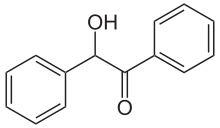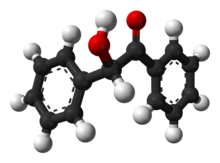بنزوين

| |

| |
| الأسماء | |
|---|---|
| اسم أيوپاك المفضل
2-Hydroxy-1,2-diphenylethan-1-one | |
| أسماء أخرى
2-Hydroxy-2-phenylacetophenone
2-Hydroxy-1,2-diphenylethanone Desyl alcohol Bitter almond oil camphor | |
| المُعرِّفات | |
| رقم CAS | |
3D model (JSmol)
|
|
| 3DMet | |
| مرجع بايلستاين | 391839 |
| ChEBI | |
| ChEMBL | |
| ChemSpider | |
| ECHA InfoCard | 100.003.938 |
| KEGG | |
PubChem CID
|
|
| رقم RTECS |
|
| UNII | |
CompTox Dashboard (EPA)
|
|
| الخصائص | |
| الصيغة الجزيئية | C14H12O2 |
| كتلة مولية | 212.23 g mol-1 |
| المظهر | Off-white crystals |
| الكثافة | 1.310 g/cm3 (20 °C)[1] |
| نقطة الانصهار | |
| نقطة الغليان | |
| قابلية الذوبان في الماء | Slightly soluble |
| قابلية الذوبان في ethanol | Very good[1] |
| قابلية الذوبان في ether | Slightly soluble |
| قابلية الذوبان في chlorine | Soluble |
| قابلية الذوبان في chloroform | Very good[1] |
| المخاطر | |
| H412 | |
| P273, P501 | |
| NFPA 704 (معيـَّن النار) | |
| الجرعة أو التركيز القاتل (LD, LC): | |
LD50 (الجرعة الوسطى)
|
10.000 mg/kg |
ما لم يُذكر غير ذلك، البيانات المعطاة للمواد في حالاتهم العيارية (عند 25 °س [77 °ف]، 100 kPa). | |
| مراجع الجدول | |
البنزوين Benzoin هو مركب عضوي يتكون من الإيثيلين الذي يربط بين الفينيل الهيدروكسيل والكيتون. It appears as off-white crystals, with a light camphor-like odor. Benzoin is synthesized from benzaldehyde in the benzoin condensation. It is chiral and it exists as a pair of enantiomers: (R)-benzoin and (S)-benzoin.
ولا يدخل البنزوين في تكوين الراتينج بنزويني المستخرج من الأشجار البنزوينية (الأصطركيات) حيث أن المادة المكونة لها هي حمض البنزويك.
تاريخ
Benzoin was first reported in 1832 by Justus von Liebig and Friedrich Woehler during their research on oil of bitter almond, which is benzaldehyde with traces of hydrocyanic acid.[2] The catalytic synthesis by the benzoin condensation was improved by Nikolay Zinin during his time with Liebig.[3][4]
الاستخدامات
The main use of benzoin is as a precursor to benzil, which is used as a photoinitiator.[5][6] The conversion proceeds by organic oxidation using copper(II),[7] nitric acid, or oxone. In one study, this reaction is carried out with atmospheric oxygen and basic alumina in dichloromethane.[8]
Benzoin also sees wide spread use in powder coating formulations, where it acts as a degassing agent during the curing stage. This action prevents surface defects such as 'pinholing'.[9][10]
Benzoin can be used in the preparation of several pharmaceutical drugs including oxaprozin, ditazole, and phenytoin.[11]
التحضير
Benzoin is prepared from benzaldehyde via the benzoin condensation.[12]
المصادر
- ^ أ ب ت ث ج William M. Haynes (2016). CRC Handbook of Chemistry and Physics (97th ed.). Boca Raton: CRC Press. p. 3-40. ISBN 978-1-4987-5429-3.
- ^ Wöhler, Liebig; Liebig (1832). "Untersuchungen über das Radikal der Benzoesäure". Annalen der Pharmacie. 3 (3): 249–282. doi:10.1002/jlac.18320030302. hdl:2027/hvd.hxdg3f.
- ^ N. Zinin (1839). "Beiträge zur Kenntniss einiger Verbindungen aus der Benzoylreihe". Annalen der Pharmacie. 31 (3): 329–332. doi:10.1002/jlac.18390310312. Archived from the original on 2022-07-09. Retrieved 2020-09-10.
- ^ N. Zinin (1840). "Ueber einige Zersetzungsprodukte des Bittermandelöls". Annalen der Pharmacie. 34 (2): 186–192. doi:10.1002/jlac.18400340205. Archived from the original on 2022-07-09. Retrieved 2019-06-30.
- ^ Hardo Siegel, Manfred Eggersdorfer "Ketones" in Ullmann's Encyclopedia of Industrial Chemistry Wiley-VCH, 2002 by Wiley-VCH, Wienheim. DOI:10.1002/14356007.a15_077
- ^ Nakamura, Kenichiro (2015). Photopolymers : photoresist materials, processes, and applications. Boca Raton, FL. ISBN 978-1-4665-1731-8. OCLC 884012539.
{{cite book}}: CS1 maint: location missing publisher (link) - ^ قالب:OrgSynth
- ^ Konstantinos Skobridis; Vassiliki Theodorou; Edwin Weber (2006). "A very simple and chemoselective air oxidation of benzoins to benzils using alumina". Arkivoc. 06-1798JP: 102–106.[dead link]
- ^ Maxwell, B.E; Wilson, R.C; Taylor, H.A; Williams, D.E; Farnham, W; Tria, J (November 2001). "Understanding benzoin's mode of action in powder coatings". Progress in Organic Coatings. 43 (1–3): 158–166. doi:10.1016/S0300-9440(01)00181-3.
- ^ Jahromi, Shahab; Mostert, Ben; Derks, Andreas; Koldijk, Fokelien (December 2003). "Mechanism of action of benzoin as a degassing agent in powder coatings". Progress in Organic Coatings. 48 (2–4): 183–193. doi:10.1016/S0300-9440(03)00096-1.
- ^ U.S. Patent 2٬242٬775
- ^ قالب:OrgSynth
وصلات خارجية
- Benzoin synthesis, Organic Syntheses, Coll. Vol. 1, p.94 (1941); Vol. 1, p.33 (1921)
